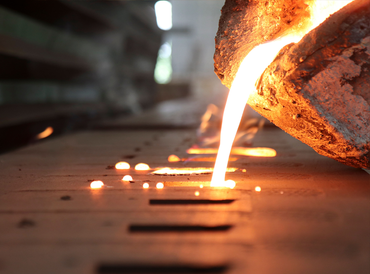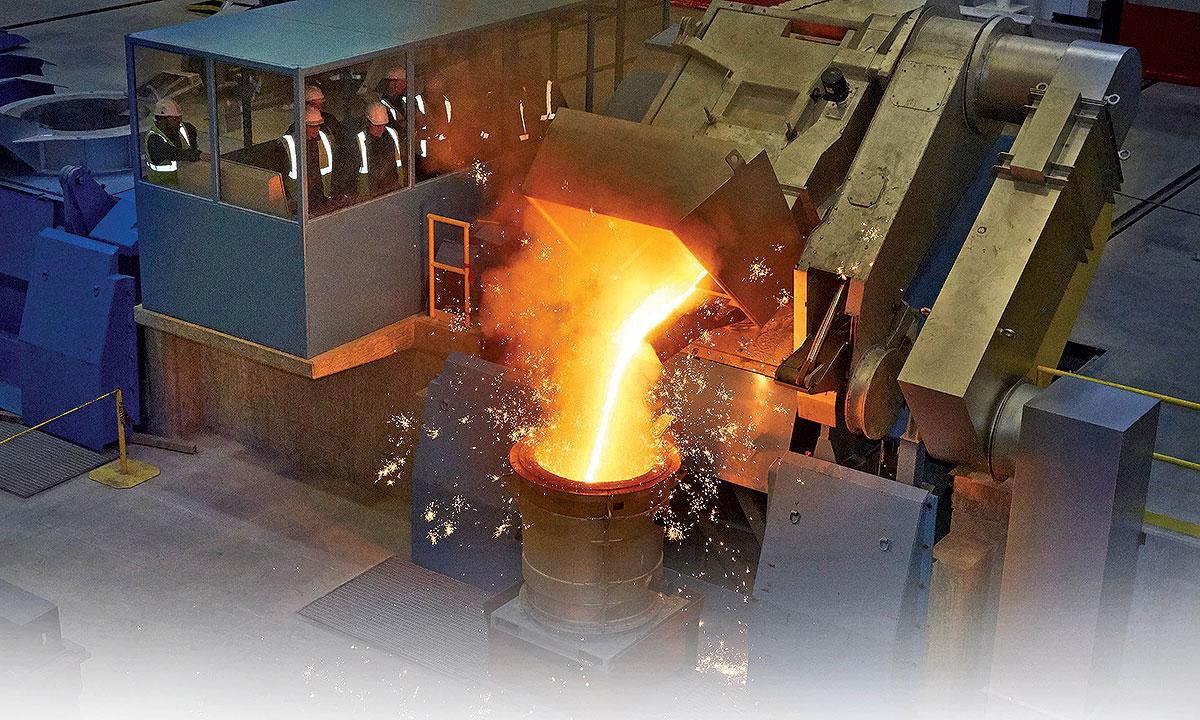Breaking Down the Aluminum Casting Process: How It Works
Wiki Article
Everything About Metal Casting: Just How Foundries Provide Quality and Precision in Manufacturing
Metal casting stands as a foundational process in production, where raw steels are changed right into particular components. Foundries employ various casting approaches to attain preferred characteristics and shapes. Each technique features its own set of benefits and limitations. Recognizing these nuances is essential for appreciating just how high quality and precision are preserved throughout the process. The conversation in advance will check out the elaborate characteristics of metal casting and its importance across several industries.The Basics of Metal Casting
Metal casting is a basic procedure in making that involves forming liquified metal into desired types. This essential technique begins with the choice of raw products, typically different metal alloys, which are thawed in a furnace. As soon as the metal gets to the appropriate temperature, it comes to be ready and liquid for casting.The process needs a mold and mildew, commonly made from sand, metal, or ceramic, which defines the final shape of the cast things. When the molten metal is put right into the mold and mildew, it solidifies and cools down, tackling the mold's shapes.
After cooling down, the casting is eliminated from the mold and mildew, and any required completing processes, such as cutting or brightening, are carried out. This method allows manufacturers to generate complicated forms and components with high precision and very little waste. Metal casting is widely utilized across various sectors, from auto to aerospace, emphasizing its relevance in contemporary production.
Sorts Of Casting Approaches
While numerous casting methods exist, each technique is and uses distinct benefits fit for various applications. Sand casting, among the most typical approaches, makes use of sand as the mold material, permitting complex layouts and huge parts. Financial investment casting, understood for its precision, employs a wax pattern covered in ceramic, making it ideal for intricate geometries. Pass away casting, which involves requiring molten metal right into molds under high pressure, is frequently utilized for automation of tiny, thorough elements. Furthermore, covering molding combines sand and resin to produce thinner, a lot more accurate mold and mildews, enhancing surface area finish. An additional technique, constant casting, enables the production of lengthy sizes of metal shapes, improving manufacturing procedures. Each of these techniques plays a critical role in the metal casting sector, resolving certain needs from manufacturing quantity to create complexity, consequently adding to the diversity of applications across various industries.The Role of Foundries in Manufacturing
Foundries offer a vital feature in the production landscape, as they transform raw metals right into usable elements via various casting processes. These centers employ a variety of strategies to produce items that meet specific requirements, thus making sure quality and effectiveness in manufacturing (Metal Casting). By making use of approaches such as sand casting, investment casting, and die casting, foundries cater to diverse markets, including automobile, aerospace, and building and construction
Inevitably, factories are essential to the production ecological community, offering crucial components that support a broad array of applications and markets. Their precision and versatility drive efficiency in modern-day production.
Products Used in Metal Casting
The choice of materials made use of in metal casting is crucial for attaining the preferred properties and performance of the end product. Different steels such as iron, light weight aluminum, and bronze are typically utilized, each offering distinct advantages. Aluminum is favored for its corrosion-resistant and light-weight high qualities, making it suitable for auto and aerospace applications. Iron, particularly cast iron, is known for its exceptional fluidness and strength, ideal for heavy equipment and framework elements. Bronze, with its superior wear resistance, is often made use of in marine environments.In addition, materials such as silica sand are frequently utilized for mold and mildew production, offering a fine balance between sturdiness and convenience of shaping. The selection of products also consists of additives like changes, which enhance the casting process by enhancing fluidness and decreasing oxidation. Eventually, the suitable option of these materials greatly affects the efficiency and top quality of the casting process.
High quality Control in the Casting Process
Quality assurance in the casting process is necessary to assure that end products meet industry criteria and requirements. Numerous assessment methods are employed to identify defects and assess the integrity of cast components. Additionally, adherence to developed certifications and criteria improves the dependability and efficiency of actors materials.Examination Techniques Employed
Maintaining the integrity of cast metal elements relies greatly on numerous evaluation techniques. Foundries utilize aesthetic examinations as an initial procedure to determine surface flaws, such as fractures or additions. Non-destructive testing (NDT) methods, including ultrasonic testing and radiographic evaluation, are vital for finding internal defects without endangering the component's stability. Dimensional evaluations utilizing calipers and coordinate measuring equipments confirm that parts satisfy specified tolerances. Additionally, chemical analysis validates that the alloy structure straightens with needed criteria. These assessment techniques collectively validate that the castings satisfy the needed high quality and performance standards, eventually lessening the threat of failure in their intended applications. Implementing these rigorous inspections is essential for preserving high standards in metal casting production.Criteria and Certifications
Requirements and certifications play a vital duty in the high quality control of the casting procedure. Foundries abide by various international and industry-specific criteria, such as ISO 9001 and ASTM guidelines, assuring uniformity and reliability in their products. These criteria outline the necessary standards for products, manufacturing approaches, and testing treatments, adding to a much more reliable production process. Certifications, such as AS9100 for aerospace applications, better emphasize the importance of quality control in specialized markets. By getting these qualifications, shops demonstrate their commitment to excellence, enhancing and reducing defects consumer contentment. Normal audits and examinations validate conformity, promoting continual renovation and advancement within the sector. Ultimately, adherence to established criteria cultivates trust between manufacturers and clients.Developments in Casting Modern Technology

3D Printing Integration
Incorporating 3D printing innovation into metal casting procedures is reinventing the production landscape. This innovative combination enhances the style and production of complex geometries that typical approaches struggle to attain. By employing additive manufacturing for creating cores and molds, factories can substantially minimize preparations and material waste. 3D printing allows for quick prototyping, making it possible for makers to check styles quickly and effectively, thereby helping with repetitive renovations. This innovation also sustains the manufacturing of light-weight components, which are necessary in sectors such as aerospace and auto. As an outcome, the combination of 3D printing not only simplifies operations however likewise raises the precision and top quality of cast metal products, marking a noteworthy advancement in the industry.Automated Manufacturing Processes
The advancements in 3D printing have paved the way for further developments in computerized manufacturing procedures within metal casting. Foundries are significantly adopting robotics and automation to enhance effectiveness and precision. Automated systems streamline the whole casting workflow, from mold and mildew production to pouring and finishing. Smart sensing units and real-time surveillance enable precise control of temperature levels and material circulation, decreasing waste and boosting high quality. Additionally, software remedies help with better style and simulation, enabling producers to enhance procedures before production begins. These computerized manufacturing procedures not only reduce labor prices yet additionally minimize human mistake, making sure regular outcome. Consequently, the combination of sophisticated modern technologies in metal casting is changing production capabilities and meeting the growing demands of various industries.Advanced Product Growth
As sectors require higher performance and sustainability, advancements in product advancement for metal casting are becoming an important emphasis. Researchers and engineers are checking out brand-new alloys and composites that enhance mechanical homes while minimizing ecological effect. Developments include light-weight products that preserve strength, enabling far better gas effectiveness in transport applications. In addition, the consolidation of recycled materials is ending up being more common, lining up with sustainability objectives. Advanced casting strategies, such as 3D printing and precision molding, permit the creation of complex geometries that conventional techniques can not achieve. These advancements not only improve the performance of actors parts but also improve production effectiveness. Overall, the continual development of material scientific research drives the future of metal casting, satisfying the needs of contemporary markets.
Applications of Metal Casting Throughout Industries
Metal casting plays an essential function in numerous industries, as it permits the manufacturing of intricate forms and top notch components with family member efficiency - Aluminum Foundry. In the vehicle industry, cast metals are crucial for producing engine blocks, transmission instances, and various other vital parts that need sturdiness and precision. Aerospace sectors use metal casting for components like generator blades and architectural aspects, where dependability is criticalAdditionally, machinery and equipment manufacturing benefit from metal casting by generating equipments, housings, and various other elaborate components that boost capability. The building and construction market likewise employs metal casting for building functions, architectural assistances, and fittings, showcasing flexibility.
The medical field relies on actors steels for surgical instruments and implants, emphasizing the demand for biocompatibility. Generally, metal casting is a fundamental process throughout several markets, offering solutions that fulfill rigid high quality standards and performance requirements.
Often Asked Questions
hereWhat Precaution Are Taken in Metal Casting Foundries?
In metal casting foundries, safety and security measures include safety equipment, air flow systems, regular equipment upkeep, staff member training, and emergency situation procedures to mitigate risks related to high temperatures, harmful materials, and potential crashes throughout the casting process.Just How Do Foundries Take Care Of Waste and Environmental Effect?
Foundries handle waste and ecological influence through reusing products, executing purification systems for exhausts, and sticking to regulations - Aluminum Foundry. They additionally take on lasting methods, such as lowering energy consumption and using eco-friendly compounds in their proceduresWhat Are the Prices Associated With Metal Casting Processes?
The prices connected with metal casting processes consist of raw materials, labor, tools maintenance, power intake, and waste administration. Furthermore, fluctuations in market prices and compliance with environmental policies can considerably affect total expenditures for foundries.Exactly How Does Metal Casting Contrast to Other Manufacturing Methods?
Metal casting uses unique advantages, such as intricate shapes and high product effectiveness, contrasted to approaches like machining or stamping. However, it may include much longer preparations and higher initial expenses, depending on task specs.
What Occupation Opportunities Exist in the Metal Casting Industry?
The metal casting sector offers different career chances, consisting of shop management, procedure engineering, quality control, mold style, and machine procedure. Experts can additionally go after duties in research and development, sales, and ecological health and wellness.Metal casting stands as a foundational procedure in production, where raw metals are changed right into specific elements. Metal casting is an essential procedure in manufacturing that entails shaping liquified metal into desired types. Another approach, continuous casting, allows the production of long sizes of metal forms, enhancing production procedures. The costs associated with metal casting procedures consist of raw materials, labor, tools upkeep, power usage, and waste management. The metal casting industry offers various career opportunities, including foundry administration, process engineering, top quality assurance, mold layout, and machine procedure.
Report this wiki page